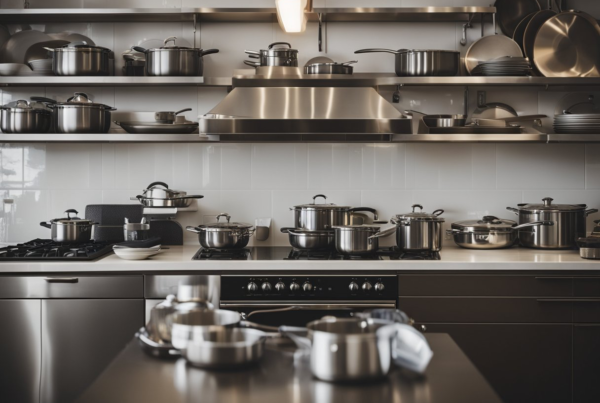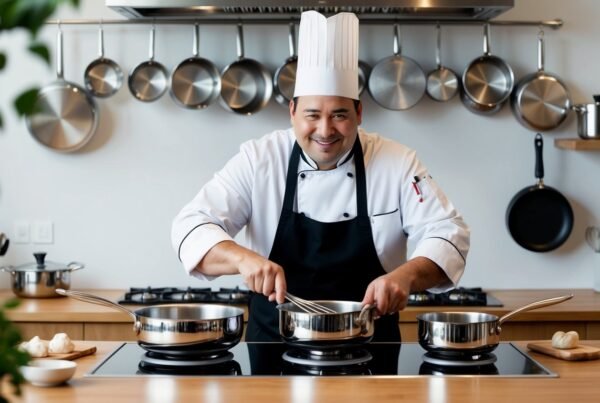A stand mixer is a game-changing appliance that transforms home cooking and baking. The KitchenAid Pro 600 Series and Cuisinart Precision Master are top choices for serious home chefs, offering professional-grade performance and durability.

Modern stand mixers come in various sizes and power levels to match different cooking needs. Many models feature multiple speed settings and versatile attachments that handle everything from whipping cream to kneading bread dough.
The latest high-end mixers blend style with function, featuring sleek designs and stunning color options that complement modern kitchens. These machines are built to last, making them a worthwhile investment for dedicated home cooks.
Key Takeaways
- Professional-grade stand mixers offer exceptional power and versatility for serious home baking
- Quality mixers include multiple attachments and speed settings for precise control
- Premium models combine durability with stylish designs that enhance kitchen aesthetics
Choosing the Best Stand Mixer for Your Kitchen

A stand mixer represents a significant investment for your kitchen. The right model needs to match your cooking style, counter space, and the types of recipes you make most often.
Evaluating Mixer Capacity and Size
The KitchenAid Artisan 5-quart mixer offers an ideal size for most home bakers. This capacity handles up to 9 dozen cookies or 4 loaves of bread at once.
Bowl size ranges from 3.5 to 8 quarts. A 5-quart bowl works well for most households, while 7-quart models suit large families or frequent entertainers.
Consider your counter space carefully. Standard mixers measure about 14 inches tall and 9 inches wide. Leave extra room for the bowl-lift mechanism or tilting head movement.
Motor Power and Performance Assessment
Look for motors rated between 325 and 575 watts. The Cuisinart Precision Stand Mixer excels at heavy-duty tasks with its robust motor design.
Key power features to check:
- Consistent speed settings
- Quiet operation
- Planetary mixing action
- Metal gears instead of plastic
A powerful motor prevents strain during thick doughs and ensures years of reliable service. Professional-grade models often include overload protection.
Comparing Tilt-Head and Bowl-Lift Models
Tilt-head mixers provide easy access to the bowl and beaters. They work best for occasional bakers with lighter recipes.
Bowl-lift designs offer greater stability for heavy doughs. The bowl raises to meet the attachments, creating a sturdier mixing platform.
Tilt-Head Benefits:
- Easier bowl access
- More compact storage
- Usually less expensive
Bowl-Lift Advantages:
- Better stability
- Handles heavy loads
- Often more powerful
Essential Stand Mixer Attachments and Accessories

A quality stand mixer becomes even more valuable with the right attachments and accessories. The proper tools transform a basic mixer into a versatile kitchen powerhouse that can handle everything from bread dough to pasta making.
Types of Standard Attachments
Every high-quality stand mixer comes with three essential attachments: the dough hook, wire whisk, and flat beater paddle.
The dough hook handles heavy-duty tasks like kneading bread and pizza dough. Its curved shape develops gluten efficiently while reducing strain on the motor.
The wire whisk excels at incorporating air into light batters, whipping cream, and beating egg whites to stiff peaks. Its multiple wire tines create optimal aeration.
The flat beater paddle is perfect for mixing cake batters, cookie dough, and frostings. Its broad surface scrapes the bowl thoroughly while creaming butter and sugar.
Specialty Attachments for Versatility
Stand mixer pasta attachments roll out perfect sheets of pasta dough and cut various noodle shapes like spaghetti, fettuccine, and lasagna. Some models even make shaped pasta like rigatoni.
A meat grinder attachment processes fresh ground meat for burgers and sausages. The food grinder also works well for breadcrumbs and grated cheese.
The ice cream maker bowl attachment freezes homemade ice cream bases while the paddle churns smooth, creamy results.
Additional Accessories for Convenience
A stainless steel mixing bowl provides durability and easy cleaning. Multiple bowl sizes allow batch flexibility.
The pouring shield prevents ingredient splatter during mixing. Its wide chute makes adding ingredients simple while the mixer runs.
Bowl scraper attachments ensure thorough mixing by continuously scraping down the sides as the paddle moves.
Extra bowls enable preparing multiple recipes without stopping to wash between tasks. Glass bowls help monitor mixing progress clearly.
Speed Options and Controls for Precision Mixing
Modern stand mixers offer precise control through multiple speed settings and digital displays. These features let home chefs achieve professional results with perfect consistency.
Understanding Speed Settings
Stand mixer speeds typically range from 1-8 or 1-10, with each level serving specific mixing needs:
Low Speeds (1-2)
- Gentle folding and initial mixing
- Starting thick batters
- Incorporating dry ingredients
Medium Speeds (3-6)
- Regular mixing for cake batters
- Creaming butter and sugar
- Beating egg mixtures
Higher mixing speeds create lighter, fluffier textures by incorporating more air. Lower speeds produce denser results, ideal for heavy doughs.
Benefits of Built-In Timers and Control Panels
Digital control panels enhance mixing precision and consistency. LED displays show exact speed settings and mixing times.
Built-in timers eliminate guesswork by:
- Tracking mixing duration automatically
- Alerting when mixing is complete
- Preventing over-mixing of delicate ingredients
Premium models feature touch-sensitive controls and preset mixing programs for common recipes. These smart features help maintain consistent results every time.
Many high-end mixers include soft-start functions that gradually increase speed to prevent ingredient splatter.
Stand Mixers in Baking and Cooking
Stand mixers excel at tough mixing tasks that would tire out even experienced bakers. The powerful motors and specialized attachments handle everything from delicate meringues to heavy bread dough.
Advantages in Baking Tasks
Professional stand mixers make quick work of whipping egg whites into stiff peaks for meringues and creating perfectly whipped cream. The whisk attachment spins rapidly, incorporating just the right amount of air.
Different speed settings give precise control over mixing intensity. Lower speeds prevent flour clouds when starting, while higher speeds create light and airy batters.
The paddle attachment thoroughly combines cake ingredients without overworking the gluten. This results in tender cakes with an even crumb structure.
Kneading Dough for Breads and Pizzas
The dough hook attachment handles the repetitive work of kneading bread and pizza dough. A 6-8 quart bowl capacity works well for making multiple loaves at once.
The hook mimics hand-kneading motions while developing proper gluten structure. Most mixers can knead continuously for 10-15 minutes without straining.
Optimal kneading speeds:
- Pizza dough: Medium-low (2-4)
- Bread dough: Medium (4-6)
- Enriched dough: Medium-high (6-8)
Creaming Butter and Sugar to Perfection
The flat beater attachment excels at creaming butter and sugar until light and fluffy. This crucial step incorporates air for tender, well-risen baked goods.
Room temperature butter creams best. The mixer should run 3-5 minutes until the color lightens and texture becomes fluffy.
Multiple speed settings allow gradual ingredient incorporation:
- Start slow to combine
- Increase to medium for creaming
- Brief high speed to aerate
Stand Mixer Maintenance and Care
Taking good care of a stand mixer helps it run better and last longer. Regular cleaning and proper maintenance will protect your investment and ensure consistent mixing results.
Cleaning and Storing Your Mixer
Proper cleaning after each use keeps your stand mixer in top shape. Always unplug the mixer before cleaning.
The stainless steel bowl needs washing in warm, soapy water after each use. Dry it thoroughly to prevent water spots.
Hand wash attachments carefully, especially whisks and beaters. Many parts are not dishwasher safe.
Wipe down the mixer body with a damp cloth. Never submerge the motor unit in water.
Store the mixer in a clean, dry place. Cover it when not in use to prevent dust buildup.
Longevity and Servicing
A well-maintained stand mixer can last over a decade with proper care. Check the motor housing screws periodically to ensure they remain tight.
Common maintenance tasks:
- Lubricate moving parts yearly
- Check power cord for damage
- Tighten attachment heads when loose
- Clean speed control dial
Watch for signs of motor strain or unusual noises. Professional servicing may be needed every few years to maintain optimal performance.
Keep the user manual handy for troubleshooting tips and proper usage guidelines. Using the correct speeds for different mixing tasks prevents motor wear.
Popular High-End Stand Mixer Models
Professional-grade stand mixers offer powerful motors, durable construction, and advanced features that make them essential tools for serious home bakers and chefs.
Examining Top Brands and Lines
The KitchenAid Artisan Series 5-Quart Tilt-Head Stand Mixer leads the market with its reliable performance and versatile attachments. It handles everything from bread dough to whipped cream with consistent results.
The Wolf Gourmet High-Performance Stand Mixer brings commercial kitchen quality home with its 7-quart bowl and 500-watt motor.
The Ankarsrum Stand Mixer stands out with its unique design – the bowl rotates while the attachments remain stationary. This European-style mixer excels at bread dough and heavy batters.
Key Features of Top Models:
- Bowl capacity: 5-7 quarts
- Motor power: 325-750 watts
- Speed settings: 6-12 options
- Included attachments: Whisk, dough hook, flat beater
Budget-Friendly Options vs. Premium Models
The Instant Pot stand mixer provides excellent value with professional features at a lower price point. It includes a 5.5-quart bowl and 600-watt motor.
Premium models like the KitchenAid Pro Line justify their higher cost through:
- All-metal construction
- Extended warranties
- Larger bowl capacities
- More powerful motors
Mid-range options like the KitchenAid Artisan balance quality and affordability while offering most essential features.
Innovative Features in New Models
Digital displays now show precise speed settings and timer functions on advanced models.
Bowl-lift designs provide better stability than tilt-head models when working with heavy doughs.
Smart features appearing in newer mixers include:
- Built-in scales
- Automatic speed adjustment
- Bowl sensing technology
- LED bowl lighting
- WiFi connectivity for recipe integration
The Breville Bakery Chef introduces touch-screen controls and preset mixing programs for consistent results.
Accommodating Stand Mixers in Small Spaces

Limited kitchen space requires smart planning and careful consideration when adding appliances. Stand mixers need both storage space and easy access for regular use.
Choosing a Stand Mixer for Limited Counter Space
Stand mixer sizes vary from 3 to 7 quarts, making it crucial to pick one that fits your space. A 3-5 quart mixer works well in compact kitchens while still handling most recipes.
Measure the available counter space carefully. A stand mixer needs at least:
- 14 inches height clearance
- 10 inches width
- 13 inches depth
Bowl-lift models take up more vertical space than tilt-head designs. Tilt-head mixers work better under cabinets since they need less clearance when opening.
Optimal Storage Solutions
Create a dedicated mixer station with easy access. A corner spot often maximizes otherwise unused space.
Pull-out shelves make heavy mixers more accessible. Install a shelf that can hold at least 30 pounds to support the mixer’s weight.
Consider spaces like deep counters or unused corners for permanent mixer placement. A 19-inch shelf height above the counter provides good clearance for most models.
Store attachments in nearby drawers or containers to keep everything organized and within reach.
Frequently Asked Questions

Stand mixers represent a significant investment for home chefs, with prices ranging from $200 to $1000. Key considerations include motor power, bowl capacity, and specialized attachments.
What factors should be considered when choosing a high-end stand mixer?
Motor power directly affects mixing performance. A high-end mixer needs at least 500 watts to handle thick doughs and large batches.
Bowl size matters for batch quantities. A 5-7 quart capacity suits most home baking needs.
Regular baking frequency should guide the investment level. Heavy users need more durable construction and stronger motors.
Which features distinguish the best stand mixers for professional-level home baking?
Multiple speed settings provide precise control. Professional models offer 10-12 speeds for different mixing needs.
Metal gears and all-metal construction ensure longevity. Plastic components wear faster under heavy use.
Planetary mixing action ensures thorough ingredient incorporation without manual scraping.
How do stand mixers vary in performance with different types of dough?
Bread dough requires strong motors and bowl-lift designs for proper kneading. Lower-powered mixers may strain with dense doughs.
Cookie and cake batters need variable speeds for proper incorporation. Too much power can overwork these softer mixtures.
What are the top recommended stand mixer brands for experienced home chefs?
The Hobart N50 offers commercial-grade performance with its 3-horsepower motor.
KitchenAid Pro series features all-metal construction and bowl-lift designs.
Bosch Universal Plus excels at bread dough with its unique drive system.
Can you compare the efficiency of tilt-head versus bowl-lift stand mixers?
Tilt-head models allow easier access to the bowl and beaters. They work best for lighter tasks and smaller batches.
Bowl-lift designs provide more stability for heavy doughs. They typically offer larger bowl capacities.
How do the warranties and after-sales support compare among premium stand mixer brands?
Premium brands typically offer 2-5 year warranties on motor and parts.
Service networks vary by manufacturer. Local repair options affect long-term ownership costs.
Replacement parts availability differs between brands. Some offer lifetime part support.



